| Article ID | Journal | Published Year | Pages | File Type |
|---|---|---|---|---|
| 3333121 | Revista Brasileira de Hematologia e Hemoterapia | 2014 | 5 Pages |
ObjectiveNewborn infants are the most heavily transfused population inside intensive care units. The hemoglobin level used to indicate the need of transfusions is not well established. The aim of this study was to evaluate transfusional practices in newborns in the neonatal intensive care units of one specific city.MethodsRed blood cell transfusion practices of all transfused newborns in all five of the neonatal intensive care units of the city were analyzed. Data are reported as descriptive statistics, including numbers and percentages and means and standard deviation. Univariate analysis, followed by stepwise logistic regression was performed in respect to transfusional data and outcomes.ResultsA total of 949 patients were admitted to the intensive care units during the 12-month study period with 20.9% receiving at least one transfusion, most (62.4%) of whom received more than one transfusion. The mean number of transfusions per infant was 2.7 ± 2.16; in the liberal transfusion group the mean number was 1.59 ± 1.63 and in the restrictive group it was 1.08 ± 1.51. The mean hemoglobin and hematocrit levels were 9.0 g/dL (±1.4 g/dL) and 27.4% (±4.3%), respectively. The most common indications for blood transfusions were sepsis and prematurity.ConclusionThis study shows that the characteristics and the transfusion practices for newborns admitted in the neonatal intensive care units of Juiz de Fora are similar to recent pubications. There was no significant reduction in the number of transfusions per child in the restrictive group compared to the liberal group. Restrictive transfusions are an independent risk factor for peri-intraventricular hemorrhages and death.
